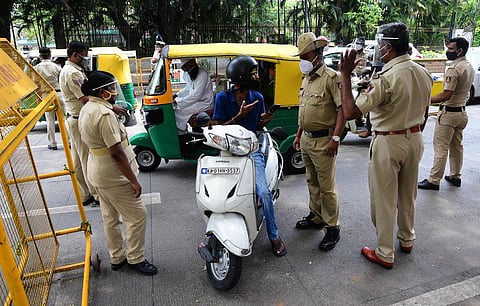

BENGALURU: The extended Covid curfew, in place in Karnataka since May 19, has been only 36 per cent effective as against 80 per cent during the May 10-24 lockdown, indicating that more stringent measures are need to contain the pandemic, reveals an analysis by a team of researchers from the Department of Computational and Data Sciences, Indian Institute of Sciences (IISc).
The finding is based on the analysis of the projection model which indicates that the actual number of Covid cases is higher than expected. The lockdown, from May 10 to May 24, was 80 per cent effective with numbers coming down as expected. But from May 19 to May 25, the actual confirmed cases are much higher than what was expected in three different scenarios. The number of confirmed cases in the worst-case scenario (of no lockdown) was expected to be 24.28 lakh; in the scenario with 50 per cent lockdown, it was to be 24.21 lakh; while in the complete effectiveness scenarios it was 24.04 lakh.
However, the confirmed cases were 24.72 lakh, which are much higher than even the worst-case scenario. It is similar with active cases, said Prof Sashikumar Ganesan, Chairman, Dept of Computational and Data Sciences. According to him, the model based on the existing actual number of cases predicted that the state will see 4,18,275 cases in the worst-case scenario, while in the actual scenario it is 4.24 lakh cases.“The lockdown extension was expected to bring down the number of confirmed and active cases, but in the last one week — from May 19 to 25 — the numbers are higher. This should be taken as a warning,” he said.
“Although we cannot directly reason that the lockdown has not been effective, he says the graph of confirmed cases in all three scenarios — no lockdown; 50 per cent effectiveness; and 100 per cent effectiveness — is much higher than what was expected at this time. The same is the case with active cases,” Prof Sashikumar Ganesan.
He points out that though the number of active cases is coming down in the actual scenario, it is still not as expected as per the model. “As per our predictions, the worst-case scenario for June 7 in terms of confirmed cases is 27.15 lakh and in terms of best scenario (100 per cent effectiveness) we have 24.52 lakh cases; and for active cases it is 3.64 lakh in worst-case scenario and 1.89 lakh in the best scenario,” he said.
There could be many possibilities for this to happen. The problem, in the present scenario as compared to the nationwide lockdown in the first wave last year is that the caseload is very high in the second wave. “Active cases currently are around 4.24 lakh. It is not that these people might spread the infection, but there are twice that number of people who could already be infected and are asymptomatic. This means around 8.5 lakh people could be roaming around infecting many others,” he explained.
The testing is important, otherwise caseload and new infections will take longer to come down, experts said.Dr Giridhara R Babu, senior epidemiologist and member of Technical Advisory Committee, Covid, said, “Lockdowns are effective only when combined with aggressive containment efforts. More people congregate in the few hours allowed while testing rates have not been appropriately increased. A certain proportion of individuals might be transmitting the infection within the families. This will have an adverse impact when unlocking begins.”